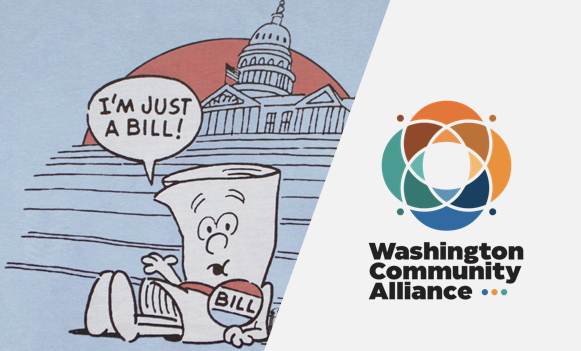
We put together a quick overview on how a bill becomes a law because the legislative session is complicated. But it doesn’t have to be.
Demystifying the legislative process
If you’re of a certain age, you’re familiar with The Schoolhouse Rock: How a Bill Becomes a Law. While it’s about the other Washington, it holds up pretty well, but let’s pull back the curtain a little. Before discussion ever starts on a bill, it’s important to know four thousand bills are introduced every session, but only a few hundred ever make it to a vote, much less become a law. Here’s a breakdown of how a bill becomes a law as told to us from insiders.
☠️ = How a bill dies here | 💪 = Actions we take to get the bill through
0️⃣ Someone writes the bill: Community develops a policy proposal or lobbies a legislator to draft a bill.
1️⃣ A committee kicks things off: Championed by a key legislator, the bill gets routed through the appropriate House or Senate committee in the first weeks of session. Assuming your bill makes it through by the deadline…
2️⃣ The money moves it forward: In the House, it’s called the Appropriations committee. In the Senate, it’s called Ways & Means. These committees control the purse strings and are, typically, the most powerful.
☠️: Because most bills require resources and because legislators hate to raise taxes — even on corporations and obscenely wealthy individuals! — we end up fighting over a steady, often shrinking pot of funds. Lots of bills die here because they don’t get funding.
3️⃣ Another committee (since committees are SOOO fun): The House and Senate caucuses set up informal rules committees. Bills that aren’t controversial usually skip this step and go to a caucus for consideration. For any other bill to move forward, it has to get “pulled” by a member of the rules committee. Each committee member will only be allowed 10–20 pulls for the entire legislative session: we have to make sure our bills are top-of-mind, or they won’t make the cut!
☠️: 90% of bills die at this point
💪: Identify all rules committee members → Advocate relentlessly as you’ll be competing with special interest group priorities → Secure commitment from a member to have your bill pulled
4️⃣ Time to caucus!: When legislators with shared goals conference together, it’s called a caucus. Caucuses can be big or small (e.g. Members of Color caucus), and they all leverage what power they have to navigate their bills through session. Each chamber has a majority and minority caucus that, typically, fall along party lines. The majority caucus runs the show. They game-plan which bills get a floor vote and which one’s they think aren’t worth the trouble. Leadership doesn’t like a divided team, so if the caucus isn’t on the same page about a bill, it tends to die — unless tradeoffs can be made to quiet the conflict.
☠️: Normally, a caucus will kill a bill if it’s perceived as weak. This could mean one of three things:
- It’ll lose a floor vote;
- It’s a controversial bill; or
- It’s ambiguous or confusing enough to slow down the process.
💪: Identify the next caucus meetings → If there’s any indication of miscommunication or ambiguity, secure member support before they caucus.
5️⃣ The floor vote, FINALLY: For all the drama a floor vote promises, at this point, things are fairly baked in. It’s very rare for a bill to make it to the floor without the majority caucus knowing the result beforehand.
☠️: Bills can still die here if a vote count is close and someone flips, or if the process for a bill is deemed incomplete, or a cowardly legislator doesn’t want to take a politically risky vote and claims the process for a bill is incomplete.
6️⃣ Rinse and repeat: After the first floor vote, it goes through this process all over again in the other chamber (e.g. once it passes in the House, it has to go through the Senate). The second chamber might reject a bill that the first one approved (☠️), or they can make edits to the bill before voting on it.
7️⃣ When the two houses disagree: There are two options. You want Concurrence, which is where the chamber of origin takes a simple vote to accept changes made by the other chamber as is. The worst of the two is Conference, where representatives from the Senate and House have to come together and try to negotiate a compromise on a quick timeline, which triggers another floor vote in both chambers.
☠️: Like any child of divorced parents at a teacher conference knows, this is often a fragile situation and really any number of issues could kill the bill.
💪: Talk with your bill sponsor → Develop a plan → Do your favorite good luck ritual.
8️⃣ Blessings from the Governor: It’s rare for a Governor to veto a bill passed by their own party, but it happens. Since it’s a budget session and the Governor has the authority to veto specific line items, we’ll want to monitor that closely.
💪: Do your due diligence and check with the Governor’s policy staff → Ensure your line item in the budget doesn’t get vetoed!
🍾 Congratulations: You made a law!
Join Us!
Sign up for our legislative newsletter The Tally to stay up to date as the bills move through the session and take action with us.




